B01DWIN309 - Developing Web Information Systems: Sunny Acres Project
VerifiedAdded on 2023/06/12
|6
|2011
|325
Project
AI Summary
This project involves the creation of a responsive website for Sunny Acres, a 200-acre farm in Bendigo, Victoria, encompassing a farm shop, pick-your-own garden, petting barn, corn maze, and holiday events. The goal is to modernize the farm's online presence with a website that adapts to various screen sizes and devices. The website should consist of approximately 10 pages with consistent styling and navigation, validated HTML and CSS, and adherence to graphic design principles. Key requirements include the use of an external stylesheet, layout using divs, meaningful text content, incorporation of at least five images per page, a contact form, and adherence to accessibility guidelines. The project emphasizes the application of progressive enhancement to optimize content delivery for both mobile and non-mobile devices. The final submission should be a zipped file containing all website files, demonstrating an understanding of web design principles and responsive design techniques.
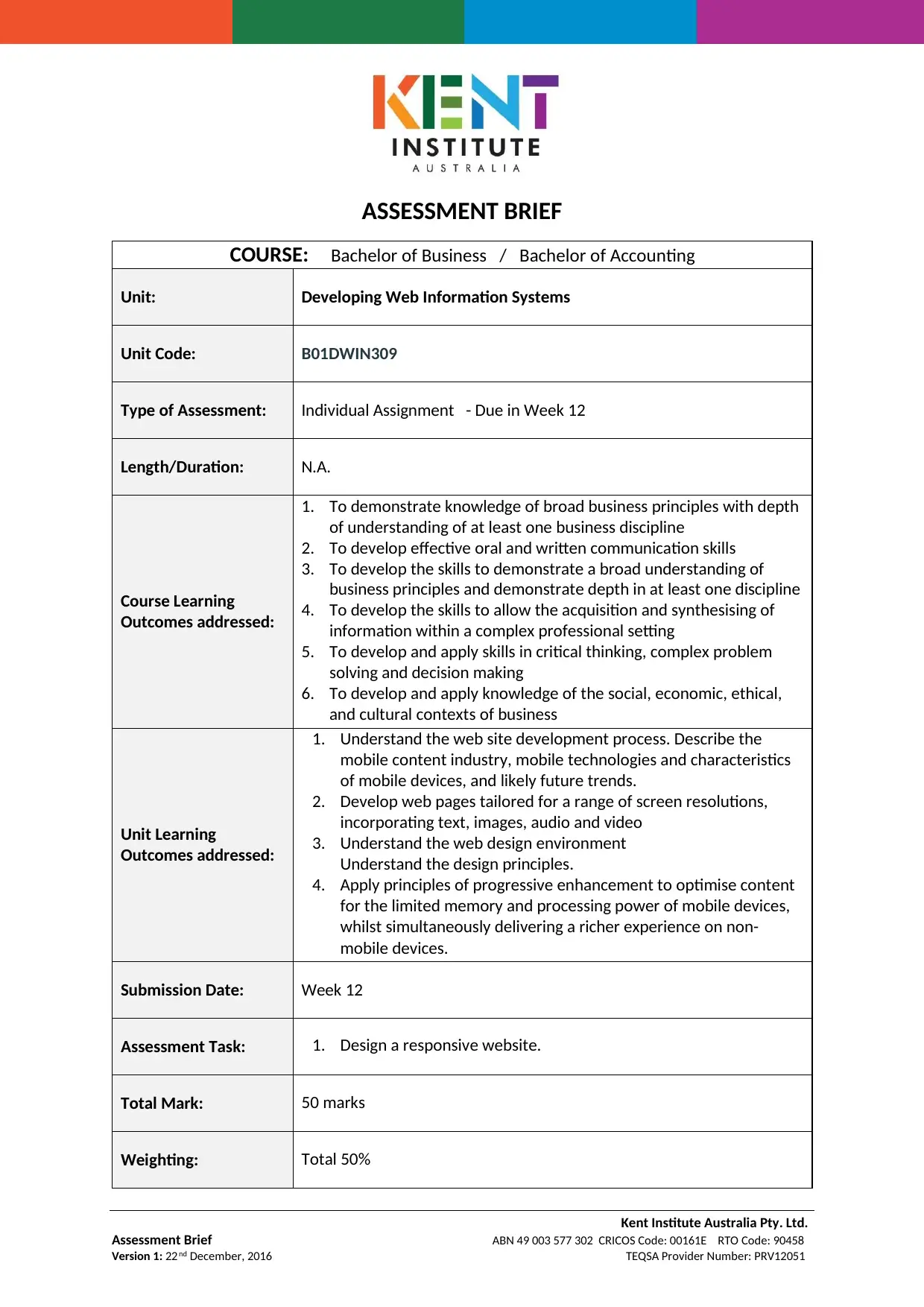
Kent Institute Australia Pty. Ltd.
Assessment Brief ABN 49 003 577 302 CRICOS Code: 00161E RTO Code: 90458
Version 1: 22nd December, 2016 TEQSA Provider Number: PRV12051
ASSESSMENT BRIEF
COURSE: Bachelor of Business / Bachelor of Accounting
Unit: Developing Web Information Systems
Unit Code: B01DWIN309
Type of Assessment: Individual Assignment - Due in Week 12
Length/Duration: N.A.
Course Learning
Outcomes addressed:
1. To demonstrate knowledge of broad business principles with depth
of understanding of at least one business discipline
2. To develop effective oral and written communication skills
3. To develop the skills to demonstrate a broad understanding of
business principles and demonstrate depth in at least one discipline
4. To develop the skills to allow the acquisition and synthesising of
information within a complex professional setting
5. To develop and apply skills in critical thinking, complex problem
solving and decision making
6. To develop and apply knowledge of the social, economic, ethical,
and cultural contexts of business
Unit Learning
Outcomes addressed:
1. Understand the web site development process. Describe the
mobile content industry, mobile technologies and characteristics
of mobile devices, and likely future trends.
2. Develop web pages tailored for a range of screen resolutions,
incorporating text, images, audio and video
3. Understand the web design environment
Understand the design principles.
4. Apply principles of progressive enhancement to optimise content
for the limited memory and processing power of mobile devices,
whilst simultaneously delivering a richer experience on non-
mobile devices.
Submission Date: Week 12
Assessment Task: 1. Design a responsive website.
Total Mark: 50 marks
Weighting: Total 50%
Assessment Brief ABN 49 003 577 302 CRICOS Code: 00161E RTO Code: 90458
Version 1: 22nd December, 2016 TEQSA Provider Number: PRV12051
ASSESSMENT BRIEF
COURSE: Bachelor of Business / Bachelor of Accounting
Unit: Developing Web Information Systems
Unit Code: B01DWIN309
Type of Assessment: Individual Assignment - Due in Week 12
Length/Duration: N.A.
Course Learning
Outcomes addressed:
1. To demonstrate knowledge of broad business principles with depth
of understanding of at least one business discipline
2. To develop effective oral and written communication skills
3. To develop the skills to demonstrate a broad understanding of
business principles and demonstrate depth in at least one discipline
4. To develop the skills to allow the acquisition and synthesising of
information within a complex professional setting
5. To develop and apply skills in critical thinking, complex problem
solving and decision making
6. To develop and apply knowledge of the social, economic, ethical,
and cultural contexts of business
Unit Learning
Outcomes addressed:
1. Understand the web site development process. Describe the
mobile content industry, mobile technologies and characteristics
of mobile devices, and likely future trends.
2. Develop web pages tailored for a range of screen resolutions,
incorporating text, images, audio and video
3. Understand the web design environment
Understand the design principles.
4. Apply principles of progressive enhancement to optimise content
for the limited memory and processing power of mobile devices,
whilst simultaneously delivering a richer experience on non-
mobile devices.
Submission Date: Week 12
Assessment Task: 1. Design a responsive website.
Total Mark: 50 marks
Weighting: Total 50%
Paraphrase This Document
Need a fresh take? Get an instant paraphrase of this document with our AI Paraphraser
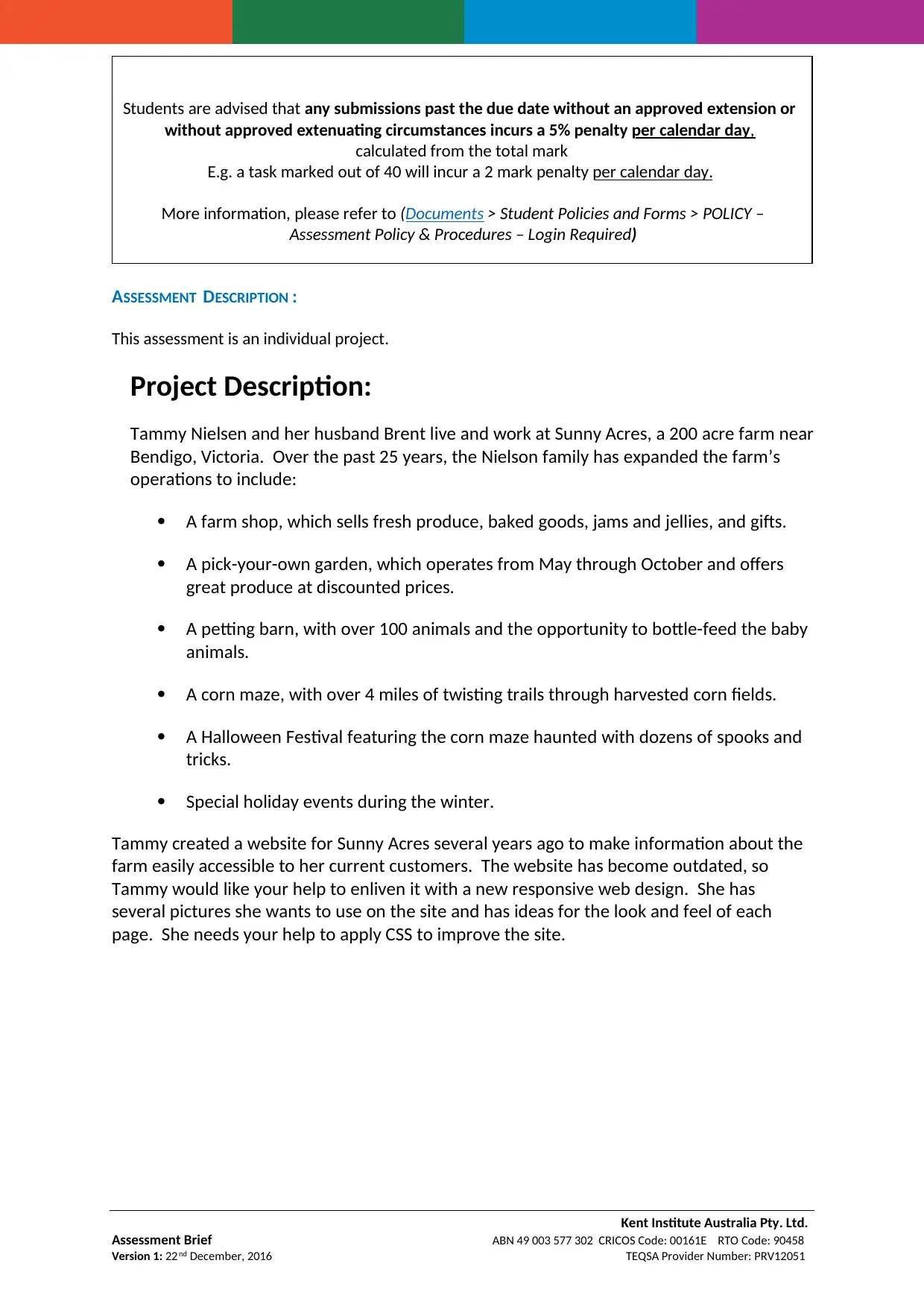
Kent Institute Australia Pty. Ltd.
Assessment Brief ABN 49 003 577 302 CRICOS Code: 00161E RTO Code: 90458
Version 1: 22nd December, 2016 TEQSA Provider Number: PRV12051
Students are advised that any submissions past the due date without an approved extension or
without approved extenuating circumstances incurs a 5% penalty per calendar day,
calculated from the total mark
E.g. a task marked out of 40 will incur a 2 mark penalty per calendar day.
More information, please refer to (Documents > Student Policies and Forms > POLICY –
Assessment Policy & Procedures – Login Required)
ASSESSMENT DESCRIPTION :
This assessment is an individual project.
Project Description:
Tammy Nielsen and her husband Brent live and work at Sunny Acres, a 200 acre farm near
Bendigo, Victoria. Over the past 25 years, the Nielson family has expanded the farm’s
operations to include:
A farm shop, which sells fresh produce, baked goods, jams and jellies, and gifts.
A pick-your-own garden, which operates from May through October and offers
great produce at discounted prices.
A petting barn, with over 100 animals and the opportunity to bottle-feed the baby
animals.
A corn maze, with over 4 miles of twisting trails through harvested corn fields.
A Halloween Festival featuring the corn maze haunted with dozens of spooks and
tricks.
Special holiday events during the winter.
Tammy created a website for Sunny Acres several years ago to make information about the
farm easily accessible to her current customers. The website has become outdated, so
Tammy would like your help to enliven it with a new responsive web design. She has
several pictures she wants to use on the site and has ideas for the look and feel of each
page. She needs your help to apply CSS to improve the site.
Assessment Brief ABN 49 003 577 302 CRICOS Code: 00161E RTO Code: 90458
Version 1: 22nd December, 2016 TEQSA Provider Number: PRV12051
Students are advised that any submissions past the due date without an approved extension or
without approved extenuating circumstances incurs a 5% penalty per calendar day,
calculated from the total mark
E.g. a task marked out of 40 will incur a 2 mark penalty per calendar day.
More information, please refer to (Documents > Student Policies and Forms > POLICY –
Assessment Policy & Procedures – Login Required)
ASSESSMENT DESCRIPTION :
This assessment is an individual project.
Project Description:
Tammy Nielsen and her husband Brent live and work at Sunny Acres, a 200 acre farm near
Bendigo, Victoria. Over the past 25 years, the Nielson family has expanded the farm’s
operations to include:
A farm shop, which sells fresh produce, baked goods, jams and jellies, and gifts.
A pick-your-own garden, which operates from May through October and offers
great produce at discounted prices.
A petting barn, with over 100 animals and the opportunity to bottle-feed the baby
animals.
A corn maze, with over 4 miles of twisting trails through harvested corn fields.
A Halloween Festival featuring the corn maze haunted with dozens of spooks and
tricks.
Special holiday events during the winter.
Tammy created a website for Sunny Acres several years ago to make information about the
farm easily accessible to her current customers. The website has become outdated, so
Tammy would like your help to enliven it with a new responsive web design. She has
several pictures she wants to use on the site and has ideas for the look and feel of each
page. She needs your help to apply CSS to improve the site.
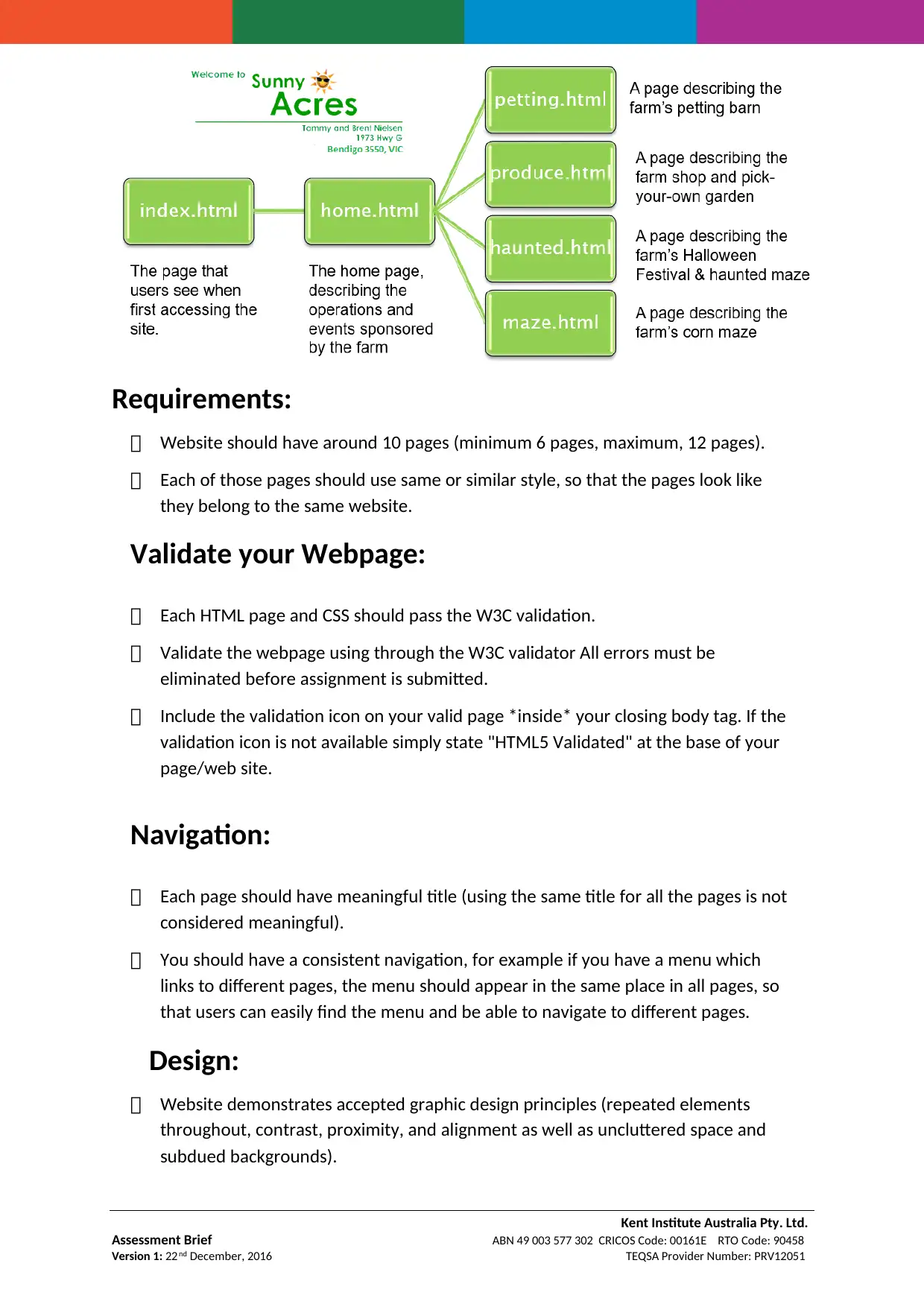
Kent Institute Australia Pty. Ltd.
Assessment Brief ABN 49 003 577 302 CRICOS Code: 00161E RTO Code: 90458
Version 1: 22nd December, 2016 TEQSA Provider Number: PRV12051
Requirements:
Website should have around 10 pages (minimum 6 pages, maximum, 12 pages).
Each of those pages should use same or similar style, so that the pages look like
they belong to the same website.
Validate your Webpage:
Each HTML page and CSS should pass the W3C validation.
Validate the webpage using through the W3C validator All errors must be
eliminated before assignment is submitted.
Include the validation icon on your valid page *inside* your closing body tag. If the
validation icon is not available simply state "HTML5 Validated" at the base of your
page/web site.
Navigation:
Each page should have meaningful title (using the same title for all the pages is not
considered meaningful).
You should have a consistent navigation, for example if you have a menu which
links to different pages, the menu should appear in the same place in all pages, so
that users can easily find the menu and be able to navigate to different pages.
Design:
Website demonstrates accepted graphic design principles (repeated elements
throughout, contrast, proximity, and alignment as well as uncluttered space and
subdued backgrounds).
Assessment Brief ABN 49 003 577 302 CRICOS Code: 00161E RTO Code: 90458
Version 1: 22nd December, 2016 TEQSA Provider Number: PRV12051
Requirements:
Website should have around 10 pages (minimum 6 pages, maximum, 12 pages).
Each of those pages should use same or similar style, so that the pages look like
they belong to the same website.
Validate your Webpage:
Each HTML page and CSS should pass the W3C validation.
Validate the webpage using through the W3C validator All errors must be
eliminated before assignment is submitted.
Include the validation icon on your valid page *inside* your closing body tag. If the
validation icon is not available simply state "HTML5 Validated" at the base of your
page/web site.
Navigation:
Each page should have meaningful title (using the same title for all the pages is not
considered meaningful).
You should have a consistent navigation, for example if you have a menu which
links to different pages, the menu should appear in the same place in all pages, so
that users can easily find the menu and be able to navigate to different pages.
Design:
Website demonstrates accepted graphic design principles (repeated elements
throughout, contrast, proximity, and alignment as well as uncluttered space and
subdued backgrounds).
⊘ This is a preview!⊘
Do you want full access?
Subscribe today to unlock all pages.

Trusted by 1+ million students worldwide
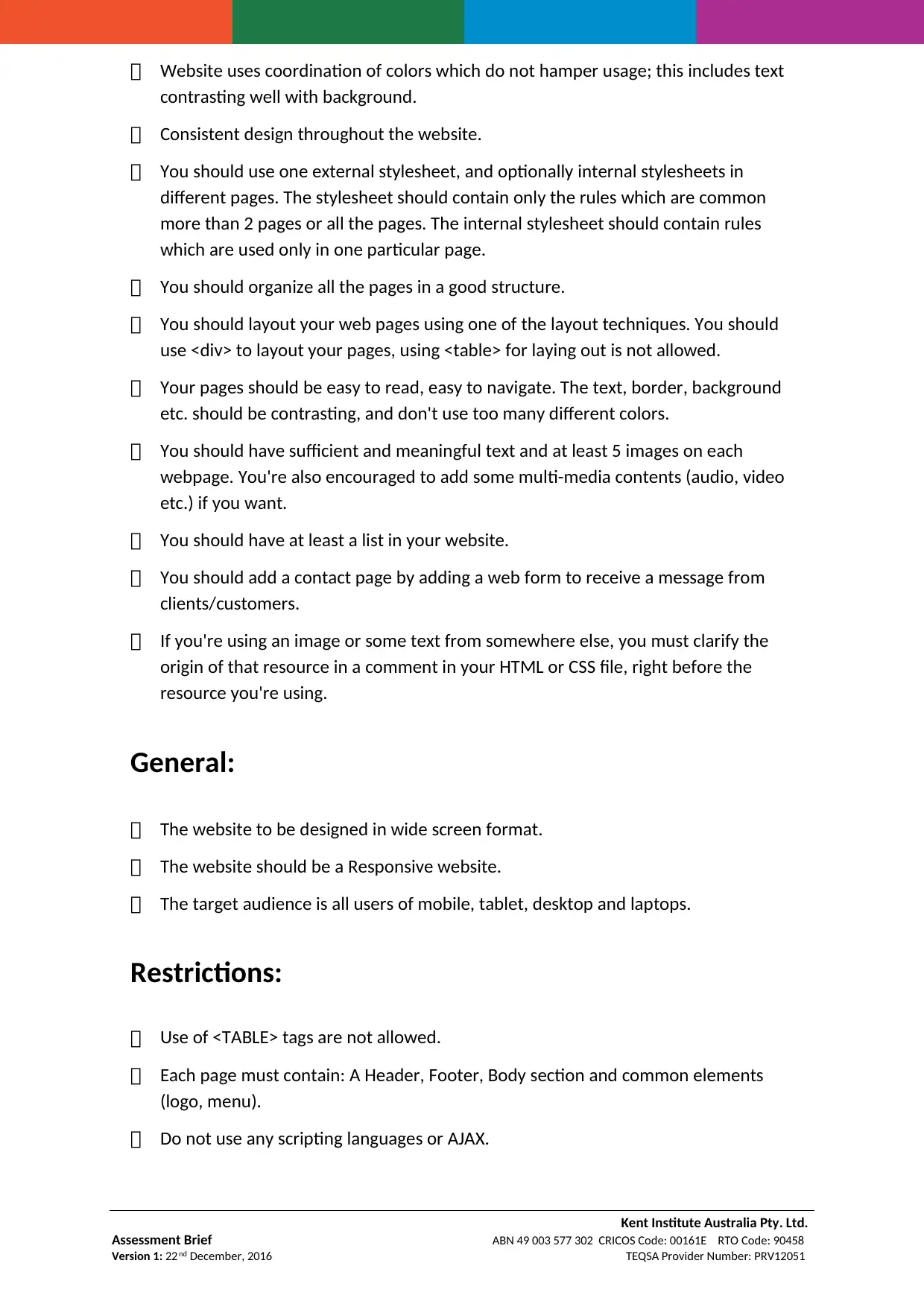
Kent Institute Australia Pty. Ltd.
Assessment Brief ABN 49 003 577 302 CRICOS Code: 00161E RTO Code: 90458
Version 1: 22nd December, 2016 TEQSA Provider Number: PRV12051
Website uses coordination of colors which do not hamper usage; this includes text
contrasting well with background.
Consistent design throughout the website.
You should use one external stylesheet, and optionally internal stylesheets in
different pages. The stylesheet should contain only the rules which are common
more than 2 pages or all the pages. The internal stylesheet should contain rules
which are used only in one particular page.
You should organize all the pages in a good structure.
You should layout your web pages using one of the layout techniques. You should
use <div> to layout your pages, using <table> for laying out is not allowed.
Your pages should be easy to read, easy to navigate. The text, border, background
etc. should be contrasting, and don't use too many different colors.
You should have sufficient and meaningful text and at least 5 images on each
webpage. You're also encouraged to add some multi-media contents (audio, video
etc.) if you want.
You should have at least a list in your website.
You should add a contact page by adding a web form to receive a message from
clients/customers.
If you're using an image or some text from somewhere else, you must clarify the
origin of that resource in a comment in your HTML or CSS file, right before the
resource you're using.
General:
The website to be designed in wide screen format.
The website should be a Responsive website.
The target audience is all users of mobile, tablet, desktop and laptops.
Restrictions:
Use of <TABLE> tags are not allowed.
Each page must contain: A Header, Footer, Body section and common elements
(logo, menu).
Do not use any scripting languages or AJAX.
Assessment Brief ABN 49 003 577 302 CRICOS Code: 00161E RTO Code: 90458
Version 1: 22nd December, 2016 TEQSA Provider Number: PRV12051
Website uses coordination of colors which do not hamper usage; this includes text
contrasting well with background.
Consistent design throughout the website.
You should use one external stylesheet, and optionally internal stylesheets in
different pages. The stylesheet should contain only the rules which are common
more than 2 pages or all the pages. The internal stylesheet should contain rules
which are used only in one particular page.
You should organize all the pages in a good structure.
You should layout your web pages using one of the layout techniques. You should
use <div> to layout your pages, using <table> for laying out is not allowed.
Your pages should be easy to read, easy to navigate. The text, border, background
etc. should be contrasting, and don't use too many different colors.
You should have sufficient and meaningful text and at least 5 images on each
webpage. You're also encouraged to add some multi-media contents (audio, video
etc.) if you want.
You should have at least a list in your website.
You should add a contact page by adding a web form to receive a message from
clients/customers.
If you're using an image or some text from somewhere else, you must clarify the
origin of that resource in a comment in your HTML or CSS file, right before the
resource you're using.
General:
The website to be designed in wide screen format.
The website should be a Responsive website.
The target audience is all users of mobile, tablet, desktop and laptops.
Restrictions:
Use of <TABLE> tags are not allowed.
Each page must contain: A Header, Footer, Body section and common elements
(logo, menu).
Do not use any scripting languages or AJAX.
Paraphrase This Document
Need a fresh take? Get an instant paraphrase of this document with our AI Paraphraser
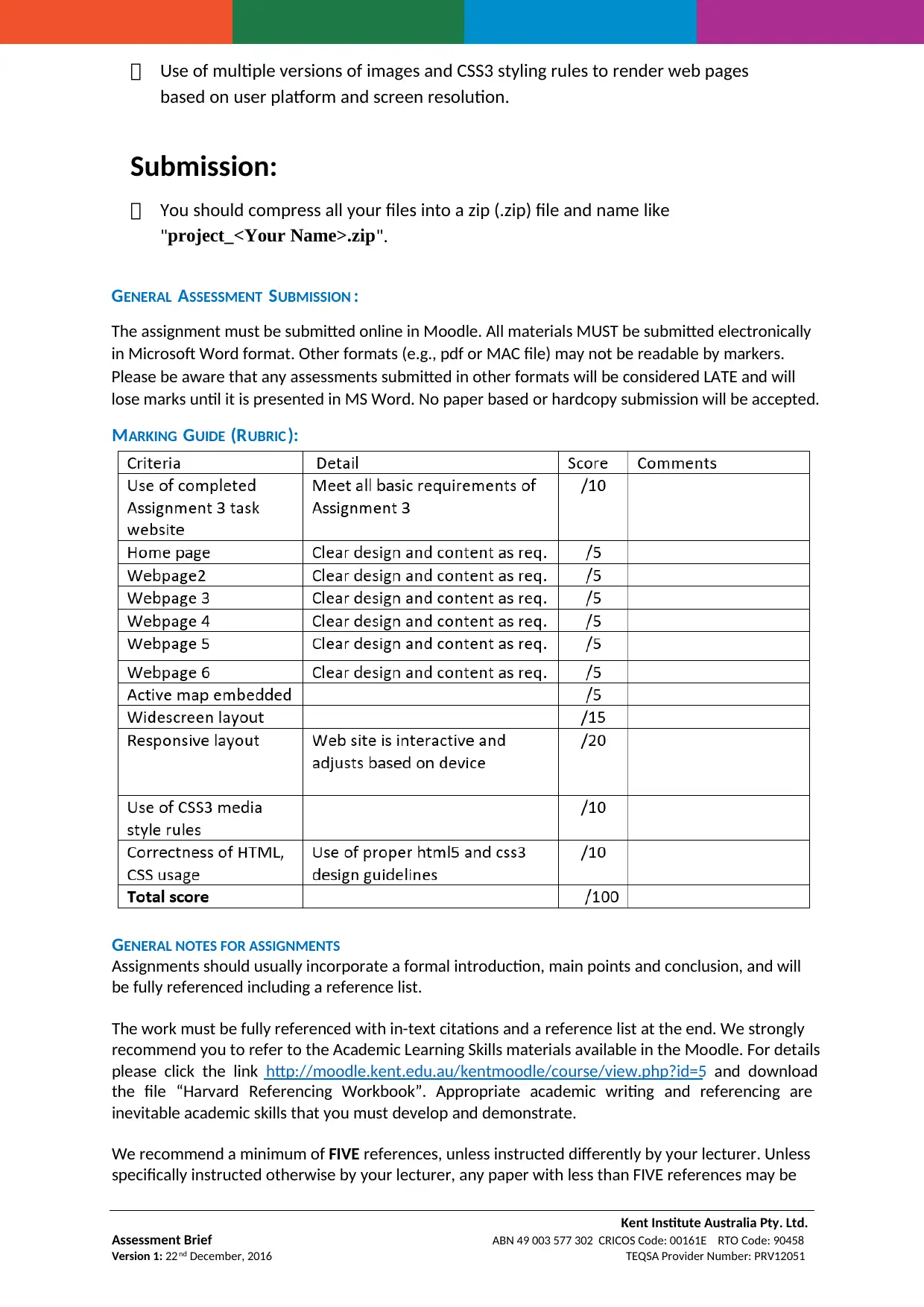
Kent Institute Australia Pty. Ltd.
Assessment Brief ABN 49 003 577 302 CRICOS Code: 00161E RTO Code: 90458
Version 1: 22nd December, 2016 TEQSA Provider Number: PRV12051
Use of multiple versions of images and CSS3 styling rules to render web pages
based on user platform and screen resolution.
Submission:
You should compress all your files into a zip (.zip) file and name like
"project_<Your Name>.zip".
GENERAL ASSESSMENT SUBMISSION :
The assignment must be submitted online in Moodle. All materials MUST be submitted electronically
in Microsoft Word format. Other formats (e.g., pdf or MAC file) may not be readable by markers.
Please be aware that any assessments submitted in other formats will be considered LATE and will
lose marks until it is presented in MS Word. No paper based or hardcopy submission will be accepted.
MARKING GUIDE (RUBRIC ):
GENERAL NOTES FOR ASSIGNMENTS
Assignments should usually incorporate a formal introduction, main points and conclusion, and will
be fully referenced including a reference list.
The work must be fully referenced with in-text citations and a reference list at the end. We strongly
recommend you to refer to the Academic Learning Skills materials available in the Moodle. For details
please click the link http://moodle.kent.edu.au/kentmoodle/course/view.php?id=5 and download
the file “Harvard Referencing Workbook”. Appropriate academic writing and referencing are
inevitable academic skills that you must develop and demonstrate.
We recommend a minimum of FIVE references, unless instructed differently by your lecturer. Unless
specifically instructed otherwise by your lecturer, any paper with less than FIVE references may be
Assessment Brief ABN 49 003 577 302 CRICOS Code: 00161E RTO Code: 90458
Version 1: 22nd December, 2016 TEQSA Provider Number: PRV12051
Use of multiple versions of images and CSS3 styling rules to render web pages
based on user platform and screen resolution.
Submission:
You should compress all your files into a zip (.zip) file and name like
"project_<Your Name>.zip".
GENERAL ASSESSMENT SUBMISSION :
The assignment must be submitted online in Moodle. All materials MUST be submitted electronically
in Microsoft Word format. Other formats (e.g., pdf or MAC file) may not be readable by markers.
Please be aware that any assessments submitted in other formats will be considered LATE and will
lose marks until it is presented in MS Word. No paper based or hardcopy submission will be accepted.
MARKING GUIDE (RUBRIC ):
GENERAL NOTES FOR ASSIGNMENTS
Assignments should usually incorporate a formal introduction, main points and conclusion, and will
be fully referenced including a reference list.
The work must be fully referenced with in-text citations and a reference list at the end. We strongly
recommend you to refer to the Academic Learning Skills materials available in the Moodle. For details
please click the link http://moodle.kent.edu.au/kentmoodle/course/view.php?id=5 and download
the file “Harvard Referencing Workbook”. Appropriate academic writing and referencing are
inevitable academic skills that you must develop and demonstrate.
We recommend a minimum of FIVE references, unless instructed differently by your lecturer. Unless
specifically instructed otherwise by your lecturer, any paper with less than FIVE references may be
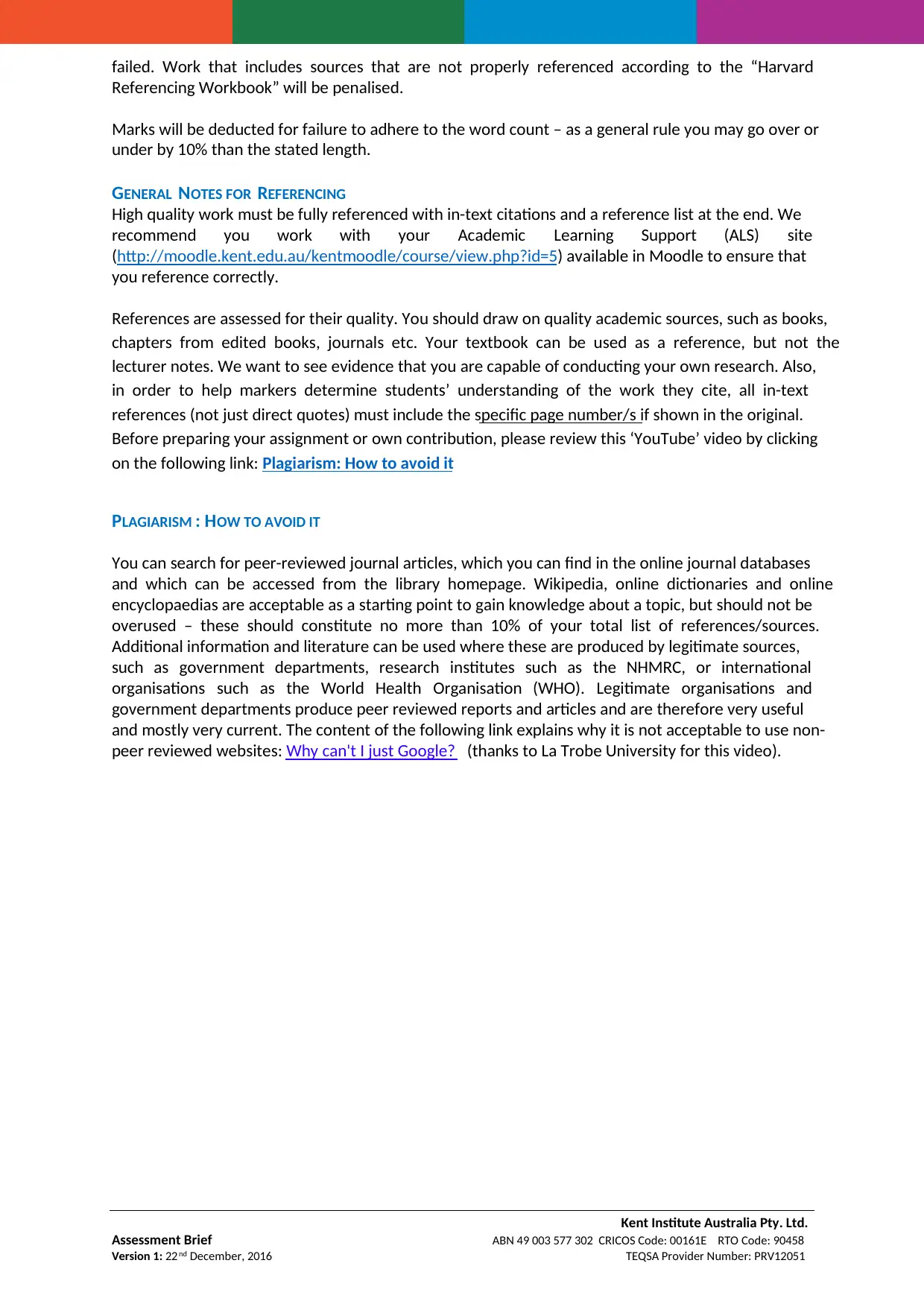
Kent Institute Australia Pty. Ltd.
Assessment Brief ABN 49 003 577 302 CRICOS Code: 00161E RTO Code: 90458
Version 1: 22nd December, 2016 TEQSA Provider Number: PRV12051
failed. Work that includes sources that are not properly referenced according to the “Harvard
Referencing Workbook” will be penalised.
Marks will be deducted for failure to adhere to the word count – as a general rule you may go over or
under by 10% than the stated length.
GENERAL NOTES FOR REFERENCING
High quality work must be fully referenced with in-text citations and a reference list at the end. We
recommend you work with your Academic Learning Support (ALS) site
(http://moodle.kent.edu.au/kentmoodle/course/view.php?id=5) available in Moodle to ensure that
you reference correctly.
References are assessed for their quality. You should draw on quality academic sources, such as books,
chapters from edited books, journals etc. Your textbook can be used as a reference, but not the
lecturer notes. We want to see evidence that you are capable of conducting your own research. Also,
in order to help markers determine students’ understanding of the work they cite, all in-text
references (not just direct quotes) must include the specific page number/s if shown in the original.
Before preparing your assignment or own contribution, please review this ‘YouTube’ video by clicking
on the following link: Plagiarism: How to avoid it
PLAGIARISM : HOW TO AVOID IT
You can search for peer-reviewed journal articles, which you can find in the online journal databases
and which can be accessed from the library homepage. Wikipedia, online dictionaries and online
encyclopaedias are acceptable as a starting point to gain knowledge about a topic, but should not be
overused – these should constitute no more than 10% of your total list of references/sources.
Additional information and literature can be used where these are produced by legitimate sources,
such as government departments, research institutes such as the NHMRC, or international
organisations such as the World Health Organisation (WHO). Legitimate organisations and
government departments produce peer reviewed reports and articles and are therefore very useful
and mostly very current. The content of the following link explains why it is not acceptable to use non-
peer reviewed websites: Why can't I just Google? (thanks to La Trobe University for this video).
Assessment Brief ABN 49 003 577 302 CRICOS Code: 00161E RTO Code: 90458
Version 1: 22nd December, 2016 TEQSA Provider Number: PRV12051
failed. Work that includes sources that are not properly referenced according to the “Harvard
Referencing Workbook” will be penalised.
Marks will be deducted for failure to adhere to the word count – as a general rule you may go over or
under by 10% than the stated length.
GENERAL NOTES FOR REFERENCING
High quality work must be fully referenced with in-text citations and a reference list at the end. We
recommend you work with your Academic Learning Support (ALS) site
(http://moodle.kent.edu.au/kentmoodle/course/view.php?id=5) available in Moodle to ensure that
you reference correctly.
References are assessed for their quality. You should draw on quality academic sources, such as books,
chapters from edited books, journals etc. Your textbook can be used as a reference, but not the
lecturer notes. We want to see evidence that you are capable of conducting your own research. Also,
in order to help markers determine students’ understanding of the work they cite, all in-text
references (not just direct quotes) must include the specific page number/s if shown in the original.
Before preparing your assignment or own contribution, please review this ‘YouTube’ video by clicking
on the following link: Plagiarism: How to avoid it
PLAGIARISM : HOW TO AVOID IT
You can search for peer-reviewed journal articles, which you can find in the online journal databases
and which can be accessed from the library homepage. Wikipedia, online dictionaries and online
encyclopaedias are acceptable as a starting point to gain knowledge about a topic, but should not be
overused – these should constitute no more than 10% of your total list of references/sources.
Additional information and literature can be used where these are produced by legitimate sources,
such as government departments, research institutes such as the NHMRC, or international
organisations such as the World Health Organisation (WHO). Legitimate organisations and
government departments produce peer reviewed reports and articles and are therefore very useful
and mostly very current. The content of the following link explains why it is not acceptable to use non-
peer reviewed websites: Why can't I just Google? (thanks to La Trobe University for this video).
⊘ This is a preview!⊘
Do you want full access?
Subscribe today to unlock all pages.

Trusted by 1+ million students worldwide
1 out of 6
Your All-in-One AI-Powered Toolkit for Academic Success.
+13062052269
info@desklib.com
Available 24*7 on WhatsApp / Email
![[object Object]](/_next/static/media/star-bottom.7253800d.svg)
Unlock your academic potential
Copyright © 2020–2025 A2Z Services. All Rights Reserved. Developed and managed by ZUCOL.